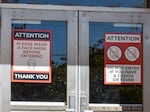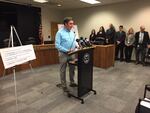
Face coverings are required for entry at Richmond Elementary in Southeast Portland, Jan. 20, 2022.
Elizabeth Miller / OPB
Last Monday, the Oregon Health Authority announced the decision to lift the indoor mask requirement on or before March 31. Health officials project roughly 400 people in Oregon will be hospitalized for COVID-19 at the end of March, a dip down to levels before the omicron variant surge.
Oregon’s state epidemiologist Dr. Dean Sidelinger joined Dave Miller on Think Out Loud recently. You can listen to the whole interview by pressing the play arrow above.
The following transcript has been edited for clarity and length.
Dave Miller: How did you decide to make this announcement?
Dean Sidelinger: We know that during the delta surge and omicron surge we’ve had, we’ve seen the highest numbers of Oregonians needing to be hospitalized with COVID. And so looking at that impact on hospitals, following the COVID positive patients in hospitals and how hospitals were doing with capacity, was really high on that list. And so by looking at where we are with our data trend, seeing decreases in cases, decreases in hospitalizations now over the last week and a half or so, where our projections say we would be, that would put us at about 400 Oregonians in the hospital by the end of March. And that’s about where we were before omicron hit at a time when hospitals were much better able to care for the patients they had in the hospital without the strain they’re seeing now.
Dave Miller: I’m interested in this 400 hospitalization number because back in August at the beginning of the delta surge, the mask mandate was reinstated when only around 150 Oregonians were then hospitalized with COVID-19. Why are the metrics so different now?
Dean Sidelinger: I think we always have to look at what’s the situation in front of us and whether there are tools we have to combat that disease. We now have many more Oregonians who are up to date with their vaccinations, including getting their booster shots. We know that we have the arrival of more treatments. We have oral antiviral pills that can be used for those who are most at risk for serious complications to prevent them from having those complications and needing to be hospitalized.
Dave Miller: So what if hospitalizations are at 500 or 600 on March 31? So how far away from the current projections would numbers have to be for you and other state officials to say, “You know what, we’re going to change what we said we’re going to do?”
Dean Sidelinger: I think we wouldn’t change what we said we would do but we would message more if cases aren’t coming down as quickly as we want. But especially those individuals who are more at risk for complications from COVID they’re immunocompromised, so perhaps they don’t have as much protection from their vaccine. They’re older Oregonians or have chronic conditions that would put them more at risk, they may consider not changing their behavior, wearing their masks, limiting their time indoors with others.
The requirement to wear masks in indoor public places and our K-12 schools will end on March 31 at the latest.
Dave Miller: Even if there is a new, even more serious variant?
Dean Sidelinger: I think if there’s a more severe variant that’s significantly more transmissible, causing more severe disease, we will be in the early learning stages of learning about that. We will tell people what we know and don’t know whether that arrives here in Oregon and steps that people can take to protect themselves, and certainly going back to requiring masks in indoor public places could be a step we would take down the road.

State epidemiologist Dr. Dean Sidelinger speaks at an event in this file photo.
Kristian Foden-Vencil / OPB
Dave Miller. How concerned are you that by announcing the impending end of the mask mandate more than a month and a half in advance, you could end up giving the signal to a lot of Oregonians that they can take their masks off?
Dean Sidelinger: I think what I would say to Oregonians is right now is not the time to take off your mask. I think we still have over 1,000 Oregonians in the hospital who tested positive with COVID, and while that’s down significantly over the last week and a half, it’s still very high. We know that cases have come down even more dramatically. That decline started beforehand, but every county last week in Oregon still would fall into the CDC’s level of high transmission. So right now, similar to on the way up the peak, on the way down, there’s going to be a lot of COVID in the next few weeks. And the risk of getting COVID is still high here in Oregon.
By picking that date, announcing that date, we’re giving people that endpoint so that they know that the changes they’re making now, any sacrifices they’re making, are happening in this time frame.
Dave Miller: The Health Authority and the Oregon Department of Education are both saying they strongly advise continued use of masks in K-12 schools even after March 31. Where is the line for you between strongly advising something as a state epidemiologist and requiring it?
Dean Sidelinger: What we know about masks at school is they’re a key part of a multilayered strategy to prevent transmission at school. We know that being up to date with vaccinations provides great protection for the students, teachers and staff in those settings. So with multiple measures in place, by removing the mask requirement and going to recommendations, local communities, local school boards can make decisions about do they have enough of those layered mitigation strategies in place in light of their community vaccination rates, vaccination rates of children in their community, disease spread in their community, to think about lifting that mask requirement and relying on some of those other safety measures. But for now, based on the types of spread we’re seeing in communities, those masks remain an incredibly important tool to help reduce the risk of transmission in schools.
Dave Miller: Are you going to wear a mask if you go grocery shopping, say on April 1?
Dean Sidelinger: I’m struggling with the same decisions that many others are. I am up to date on my vaccinations and relatively healthy. But I do live with a relative who’s older and has underlying conditions and while she’s up to date on her vaccinations, if she gets sick with COVID, she could have more complications. So I will likely continue to be cautious and likely will wear a mask at least initially when I’m out in the grocery store and some other settings and likely won’t kind of be in large crowded indoor settings until I see case rates go down even more.
